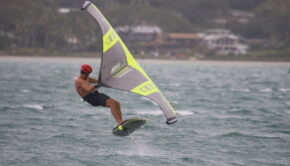Changing Sailing for Olympic audience
Published on November 8th, 2023
The mission for the Olympic Games is to unite the world in peaceful competition, and the International Olympic Committee (IOC) is evolving the event to remain relevant. As one of the original Olympic sports, Sailing has slowly shifted event format and equipment type to please the IOC, with this report by the Nacra 17 Class offering ideas in how the Mixed Multihull event can further evolve:
The Nacra 17 fleet has endorsed a two year trial period to test new formats for racing. At the 2023 Annual General Meeting (AGM), the fleet endorsed two new options to conclude regattas, specified the period of testing should be from September 2024 to September 2026, and opened the possibility for other format options to emerge.
The first format returns sailing to its roots. Instead of a medal race, the fleet will continue full fleet racing but all races on the final day would be umpired and non-discardable. Races may be reduced to 20 minutes from 30 minutes to minimize the additional broadcasting burden. Such a format would ensure the winner be revealed in the final broadcast.
Further, if fans tune in they will get to witness the very best of sailing. Fast, foiling boats in high-intensity racing, with the full complexity of fleet racing playing out at the highest level. Modern tracking and electronic systems allow for the umpiring of larger fleets than when the medal race was introduced, paving the way for a return to classic Olympic sailing.
The second format option combines all of the complexity of fleet racing with the high stakes of a knock-out tournament format. The fleet of boats will be divided into flights of eight boats, where each flight will race three normal races in low point scoring and the top half will move on to the next round. Those eliminated will move to a repechage where just a single boat will return to the final making the final a total of nine boats. In the final, there will be three fleet races and low point scoring will determine the final standings.
“The tournament format is the best fit for an IOC audience. About 30 minutes of racing over a total time of an hour will showcase every aspect of our sport and see a champion emerge in front of the spectator fleet,” said class manager Ben Remocker.
Within the tournament structure, various course configurations will be evaluated. Typical windward-leewards can work, but there is also the possibility to test reaching starts like the SailGP circuit uses and the potential to see if boundaries benefit the racing and spectator experience.
Olympic sailing is a product for the IOC, and it’s necessary to try and do better than what the medal race system has produced so far. While there have been a few sensational medal races, too often the result is already determined before the race has begun, or a large lead makes for a tenuous competitive fans experience.
This decision from the Nacra 17 class comes ahead of the release of the World Sailing Olympic Vision report, which is expected to call for a period of bold moves by sailing to ensure we maintain or grow our role within the Olympic movement.
The Nacra 17 Class has gone through a considerable evolution since its introduction for Rio 2016. The boat was designed just before the foiling revolution took off. Post Rio, the foils were updated to allow full foiling instead of skimming. The Olympic burden was also too great, so the construction was beefed up considerably with plenty of reinforcement and extra carbon fibre.
A somewhat minor tweak was added post Tokyo 2020, where an adjustable rudder was added, and it has made all the difference for the boat, which now foils upwind and allows for visually stunning and highly interesting racing.
At the 2023 AGM, the Class also approved the final update in this evolution, where the mainsail and jib will be updated to a stronger material and updated sail shape to account for the massive gains in speed the boat sees now.
Upwind speeds of about 12 knots were typical before, and now with upwind foiling speeds of 17 knots are typical. The updated mainsails should last a lot longer, and the entire construction method has been refined to match the performance of the current state of Nacra 17.
Paris 2024 Olympic Sailing Program*:
Men’s One Person Dinghy – ILCA 7 (41)
Women’s One Person Dinghy – ILCA 6 (41)
Mixed Two Person Dinghy – 470 (19)
Men’s Skiff – 49er (20)
Women’s Skiff – 49erFX (20)
Men’s Kiteboard – Formula Kite Class (20)
Women’s Kiteboard – Formula Kite Class (20)
Men’s Windsurfing – iQFoil (24)
Women’s Windsurfing – iQFoil (24)
Mixed Multihull – Nacra 17 (19)
* Quota per event in parenthesis but does not include Universality Places (2 men, 2 women)
Venue: Marseille, France
Dates: July 26-August 11
Details: https://www.paris2024.org/en/the-olympic-games-paris-2024/









 We’ll keep your information safe.
We’ll keep your information safe.